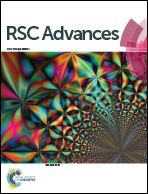A fluorescent “turn on” chemosensor based on Bodipy–anthraquinone for Al(iii) ions: synthesis and complexation/spectroscopic studies
Abstract
A novel triazole-linked Bodipy–anthraquinone compound (Bodipy-A) was easily prepared through one step click chemistry. Bodipy-A displayed a remarkable increase in fluorescence intensity in the presence of trace amounts of Al(III). These changes could be attributed to intramolecular charge transfer (ICT), and Bodipy-A also showed high selectivity over a series of other metal ions in methanol/water (9/1). The results obtained from an absorption spectroscopy titration (Job’s plot) suggested a 2 : 1 ligand-to-metal complex, which was further demonstrated by FT-IR spectroscopy. The binding constant K of the target complex was then calculated using the Benesi–Hildebrand equation. All fluorescence experiments have shown that the compound Bodipy-A has a good selectivity for Al(III) ions. The results show that this system could be used in semi-aqueous systems.


 Please wait while we load your content...
Please wait while we load your content...